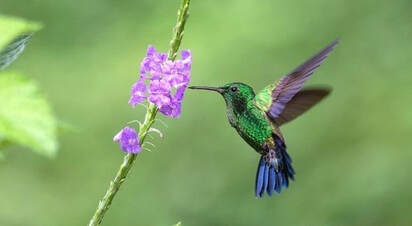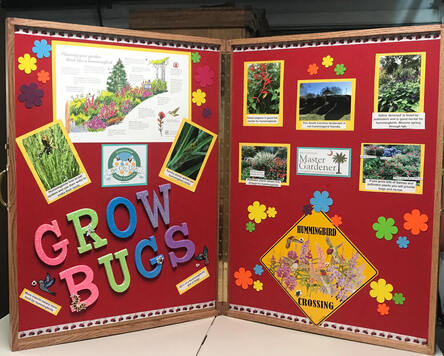
It's a nice thing to do, and the hummingbirds appreciate the easily accessible source of energizing refreshment, but they need more. Instead of fussing with sterilizing the bottle, keeping the feeder out of direct sunlight, and changing the water every couple of days, why not just provide them with native plants that would supply a continuous steady source of nectar? You can still hang up a feeder, of course, but as a supplement to nature's grand scheme of things.
Another necessity the foliage furnishes is protein. Plants attract bugs; sixty percent of the hummingbird's diet consists of bugs. Watching the tiny birds as they dart back and forth, hover, and delicately sip nectar from a flower, you'd never know they were also on the lookout for small insects, beetles, ants, aphids, gnats, and mosquitoes.
Unfortunately, meatball shrubs and tightly pruned hedges adorning residential and commercial properties leave the hunters with no nectar, no bugs, and not even any places to nest. Hummingbirds need trees, flowers, and bushes to supply the essential elements they need to thrive.
Ann Barklow, environmentalist, horticulturist, and Bee City USA liaison for the city of Greenwood, SC developed an interest in hummingbirds after moving to the south from California. She observed the overabundance of feeders along with the missing vegetation and worried the hummingbirds were not getting the nutrition they needed.
"Are we getting hummingbirds addicted to the sugar water? If given a choice, would they prefer it over searching out natural sources of nectar?" she asks.
To investigate, she grew some of the hummingbirds' favorite plants at her home. Almost immediately, they took advantage of the flowering blossoms along with the feast of insects lured in by the plants. That was a good sign. She also observed the small birds didn't fight as they tended to do around a feeder, another positive indicator. Yet one bird continually stopped and hovered in front of Ann as if asking, "Hey, where's the feeder?"
When Ann didn't succumb to its demands, the bird finally got the message and went in search of some nectar. It wasn't happy having to work for its sweet treat, but hopefully, the bonus of delicious bugs nestled in amongst the flowers made up for it.
Ann's discoveries through her backyard experiment inspired her to turn her study of hummingbirds into an educational experience for the entire community. So, with a display board and some interesting bits of information, Ann's Grow Bugs campaign began.

Ann's message was simple - grow plants that attract pollinators, pests, and other bugs because predators such as birds, bats, wasps, spiders, dragonflies, and ladybugs need the protein. "They can't survive on nectar alone. GROW BUGS!!"
What kind of plants are we talking about? Answer: flora that has always coexisted with the local fauna. Of course, this varies from region to region.
Still, you can speak with master gardeners, horticulturists, local college extension services, and any other person, groups, or organizations that are familiar with your local ecosystems and habitats. Information is also available online from the Xerces Society or your local Native Plant Society.
You can never go wrong with a few flowers from the daisy family, along with sunflowers, zinnias, and perennials like Echinacea and rudbeckia. You will have late summer and early fall blooms if you plant solidago and aster in your garden towards the end of summer. Top off your garden by tucking in some herbs. Anything in the mint family, such as thyme, sage, and basil, will bring in tons of pollinators.
Salvias (sages) are a favorite of both hummingbirds and the bugs they love to eat, such as spiders. The eight-legged hunter builds its web to trap unwary guests, and the hummingbird scores on both counts – a veritable feast of assorted bugs along with a giant, plump, juicy orb spider to top it off. Plus, the hummingbird uses the spider's web in constructing its nests.
Birds are big bug-eaters, especially caterpillars. They need lots of food to feed their babies. A chickadee needs something like 6,000 caterpillars to raise a family of four chicks. Ann says, "It'd take forever to feed their young with aphids, flies, and other small insects. They need the big plump caterpillars that have a lot of nutrients, enzymes, and other good stuff for the babies to eat."
To attract the butterflies and moths to provide the caterpillars, plant some milkweed for Monarchs or fennel for Swallowtails or other plants that'll support the voracious caterpillars. Oak trees and dogwood trees, and various shrubs are great for this. We've been conditioned to think of caterpillars and other crawling creatures eating the leaves on our plants and trees as "pests." In reality, the caterpillars are needed and sought by many birds as an essential food for their young nestlings.
Tent caterpillars overrun many yards in the spring/early summer. Instead of spraying or burning them out, use a long stick and open a big hole in the "tent" so the winged families can access the bird food.
Let Nature Take Its Course
"When you garden for nature, you can't have any preferences," Ann says. "You may like bumblebees more than spiders, but if you find a bumblebee stuck inside a web, you have to step back and let it happen."
Another thing she points out is that sometimes you have to let pests get out of control to satisfy the appetites of the predators. The birds, bats, dragonflies, ladybugs, wasps, and the rest are much better at pest control than any chemical or spray. Nature's balance always seems to save the day. When those aphids get into the milkweed, walk away and let nature take care of itself. Give it some time, and you'll notice the ladybugs (adult and larvae), hummingbirds, dragonflies, and other beneficial insects zero in on the milkweed and have a field day feasting on the aphids. Granted, it is not instantaneous, and you'll lose some of the milkweed, but the aphids are taken care of.
When you first considered planting a pollinator garden, the thought of providing food and shelter for the pollinators may not have included sacrificing some of the little creatures. It's not so disturbing when it's mosquitoes, gnats, spiders, or even ants being eaten, but it takes them all – beneficials and pests, predator and prey to maintain Mother Nature's balance.
So go ahead and plant a garden and enjoy knowing you have provided food and shelter for more than just the pollinators you see buzzing and flittering around the flowers. You have helped preserve a natural order that has existed for many millennia. Thanks to you, it will continue.
Sassy Scribblers on Conservation
 RSS Feed
RSS Feed

